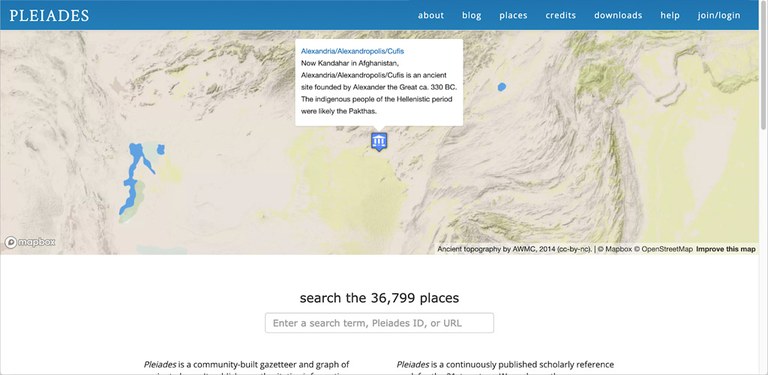Digital Programs Project Updates: Geography, Accessibility, and Pompeii
This article by Tom Elliott first appeared in ISAW Newsletter 25 (Fall 2019).
The end of summer 2019 brings the beginning of a new ISAW project and important transitions in two flagship digital projects.
Work has ramped up this summer and will continue into the fall on the Pompeii Artistic Landscape Project, funded by a grant from the Getty Foundation to Prof. Eric Poehler at the University of Massachusetts at Amherst and his ISAW collaborator Prof. Sebastian Heath. This project aims to use digital technologies to present information about Pompeian wall painting in its architectural and urban context.
 Screencapture of the Pleiades gazetteer frontpage, showcasing the location of one of the many eponymous cities (re)founded by Alexander the Great (in this case: modern Kandahar in Afghanistan).
As of August, our four-year, $322,615 grant from the National Endowment for the Humanities for major upgrades and improvements to the Pleiades gazetteer of ancient places draws to a close. This grant funded performance improvements, a faster server, and new software features for this widely used, continuously expanding resource. The resulting improvements in speed, capacity, and flexibility have enabled us to resume expanding the spatial and cultural coverage of the gazetteer and to provide geographic data and services to a wider range of internal and external digital projects. As the grant’s Principal Investigator, I will be preparing a performance report for the NEH. When it is submitted in November, it will also be published on the Pleiades website for interested parties.
Screencapture of the Pleiades gazetteer frontpage, showcasing the location of one of the many eponymous cities (re)founded by Alexander the Great (in this case: modern Kandahar in Afghanistan).
As of August, our four-year, $322,615 grant from the National Endowment for the Humanities for major upgrades and improvements to the Pleiades gazetteer of ancient places draws to a close. This grant funded performance improvements, a faster server, and new software features for this widely used, continuously expanding resource. The resulting improvements in speed, capacity, and flexibility have enabled us to resume expanding the spatial and cultural coverage of the gazetteer and to provide geographic data and services to a wider range of internal and external digital projects. As the grant’s Principal Investigator, I will be preparing a performance report for the NEH. When it is submitted in November, it will also be published on the Pleiades website for interested parties.
At this writing Kristen Soule and I are mid-way in our efforts to improve the accessibility of the ISAW website for all visitors. Part of a University-wide initiative, this work so far has entailed restructuring all our web pages to work well with screen-reading software employed by blind visitors, modifying visual styles to provide more contrast and clarity for individuals with low vision, and reconfiguring menus and links to make them easier to use for people with motion limitations. Working with our software development contractors at Jazkarta, Inc., our plan for the coming year includes the addition of descriptive text for all images previously posted to the site, as well as better structure for PDF documents so that these components work well with screen readers too. We will also work with colleagues across NYU to establish procedures and identify resources to provide transcripts of select lectures and other video resources on the website.